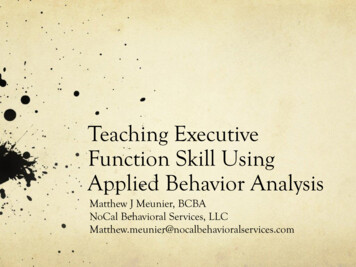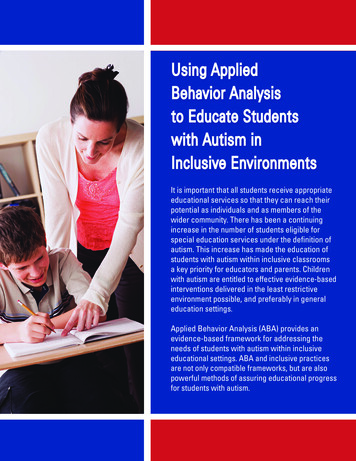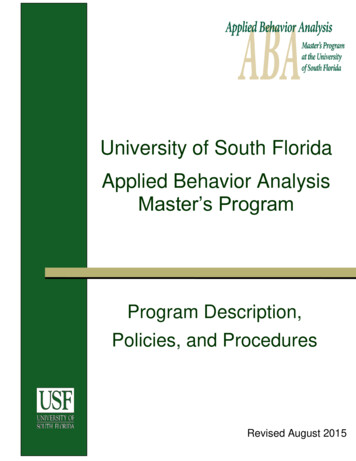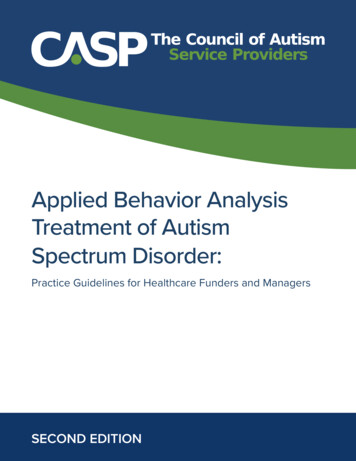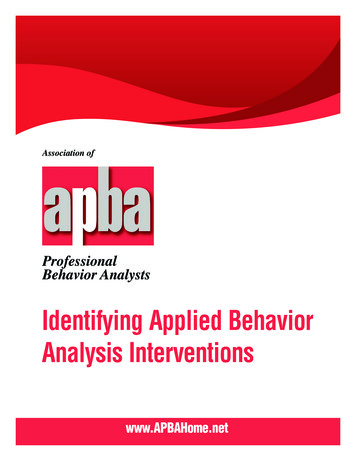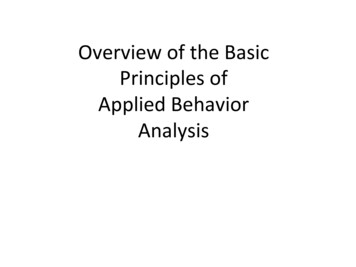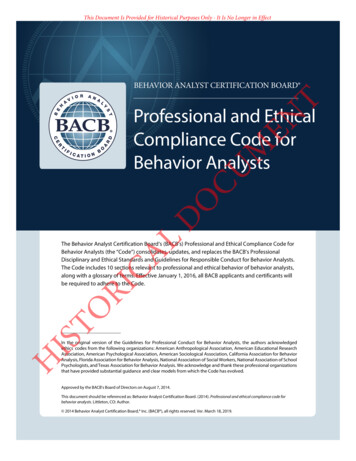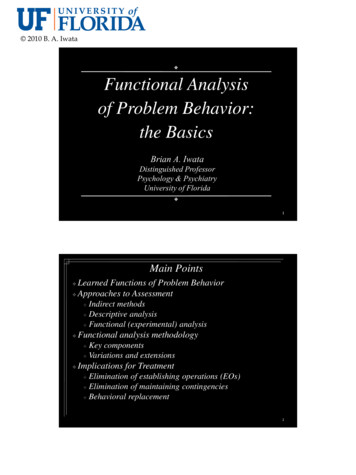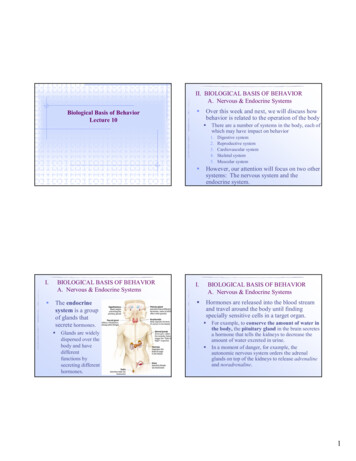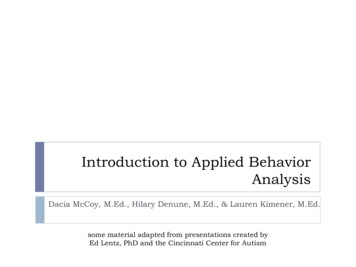
Transcription
Introduction to Applied BehaviorAnalysisDacia McCoy, M.Ed., Hilary Denune, M.Ed., & Lauren Kimener, M.Ed.some material adapted from presentations created byEd Lentz, PhD and the Cincinnati Center for Autism
Introduction to ABA Objectives History of BehaviorismWhat is ABA?Dimensions of Applied Behavior AnalysisFunctions of BehaviorFour Term ContingencyReinforcement and PunishmentMatching LawCompeting Behavior ModelMeasurement
History of Behaviorism Ivan Pavlov [1849-1936] “While you are experimenting, do not remain content with thesurface of things. ”Ivan Pavlov's discovery and research on reflexesinfluenced the growing behaviorist movement, and hiswork was often cited in John Watson’s writings.Classical conditioning/ Respondent conditioning
History of Behaviorism John Watson [1878-1958]“Father of Behaviorism”“Watson argued that the proper subject matter forpsychology was not states of mind or mental processesbut observable behavior.” [Cooper, Heron & Heward, p.9]Stimulus- Response Behaviorism
History of Behaviorism B.F. Skinner [1904-1990] “The consequences of an act affect the probability of it's occurringagain. ”Founder of experimental analysis of behaviorSkinner developed the theory of “operant conditioning,” theidea that we behave the way we do because this kind ofbehavior has had certain consequences in the past.Skinner and others outlined basic principles of behavior, whichinclude reinforcement, prompting, fading, shaping, schedules ofreinforcement, etc., etc., etc.In addition to fleshing out operant conditioning, Skinner alsoanalyzed the functions of language and presented his analysis inthe 1957 book Verbal Behavior.
History of Behaviorism B.F. Skinner [1904-1990] (Continued) Philosophy of the science of behavior (usually referred to asbehavior analysis)Holds that a science of behavior, completely natural, is possibleand desirableMentalistic explanations of behavior are not useful and oftenobscure the real reasons for behaving “Father of Radical Behaviorism”We often talk in mentalistic ways (“slipped my mind”)Private events are natural behaviors (thinking, feeling, dreaming,etc.); they are psychological activitiesActivities are extended across time and involve past andpresent, and different types of behaviors
History of Behaviorism Mental explanation examples “He only does what he wants to”“I just felt like it”“His behavior problems occur because he is so angry”“He is so unmotivated about school work”None of these are useful, and all ignore previousrelationships, learning, current conditions, etc.They do not fit into scientific ideas about behavior
History of Behaviorism Ivar Lovaas [1927-2010] “Father of ABA for autism”Lovaas TechniqueTeaching Developmentally Disabled Children: The Me Book, 1981Landmark study published in 1987 Teaching Individuals With Developmental Delays: Basic InterventionTechniques, 2000
What is Applied Behavior Analysis? Scientific approach to the study of socially significantbehavior. Applied: Applied interventions deal with problems ofdemonstrated social importance.Behavioral: Applied interventions deal with measurablebehavior (or reports if they can be validated).Analytic: Applied interventions require an objectivedemonstration that the procedures caused the effect.
What is ABA?APPLIED? BEHAVIORAL? ANAYTIC? ABA seeks to be effective (make meaningful changes)Important to analyze relationships between behavior andenvironment so we can plan interventions (analytic), or toexperimentally evaluate the effect of interventions on targetbehaviors (analytic)Must focus on changing behavior that will improve lives ofparticipants (applied)– Ethical principle– Behavior in the problem (natural) settingMust focus on the actual behavior to change (behavioral)– Must be objective/measurable– Must make sure behavior of client is changing notbehavior of observer
What is ABA?Behaviorism and conceptual behavior analysis Experimental analysis of behavior– Basic research to understand behavior– Why is animal research valued? Applied behavior analysis– Research into practice Behavioral practice– Systematically applying laws of behavior to makeimportant differences
What is ABA? BIGGEST MISCONCEPTION: ABA is something you ‘do’.NO!! ABA is the scientific approach to studying human behavior.When we implement ABA based strategies, we are applyingour understanding of the principles of behavior to ouradvantage to decrease undesirable behavior and increasefunctional behavior.
What is ABA? The only approach with research to support it’seffectiveness in treating individuals with ASD. Recommended by: Centers for Disease Control and Prevention (CDC)American Pediatric Association (APA)National Institute of Mental Health (NIMH)U.S. Surgeon GeneralAutism Society of AmericaOngoing Research Interventions based on the principles of ABA have beenestablished as effective by replicated & peer-reviewed research National Standards Project (National Autism Center)
What is ABA? Programs/ methodologies based on ABA include: Structured Teaching (TEACCH)Picture Exchange Communication Systems (PECS)Pivotal Response Training (PRT)Discrete Trial Training (DTT)Incidental TeachingPositive Behavior SupportsVerbal Behavior Analysis (VBA)* The formal programs listed above don’t necessarily identify themselves as programs utilizing theprinciples of ABA. They are however, shaping behavior by structuring the environment to elicit specificresponses and using reinforcing consequences to teach new skills.
Dimensions of Applied Behavior Analysis Baer, Wolf, and Risley (1968) recommended thefollowing seven defining dimensions for research orbehavior change programs: AppliedBehavioralAnalyticTechnologicalConceptually SystematicEffectiveGenerality
Dimensions of Applied Behavior Analysis Methods to identify and define targets for behavior change, setgoals (behavioral and applied)Identify relevant factors that may influence interventionplanning (analytic)Monitor progress and make decisions about changes(analytic, behavioral, technological)Evaluate outcomes (effective) for accountabilityDetermine if intervention is being implemented(technological)Determine if data being collected are accurate (and reflectsthe behavior of the target, not the observer) (behavioral)Determine if outcomes are socially important (effective,generality)
What is “Behavior”? “The activity of living organisms; human behavior includeseverything that people do (Cooper, Heron, Heward,2007).” Dead Person’s Test: If a dead person can do it, it is not abehavior! Examples: Receives a token, sits in chair, does not get out ofseat, wears shoes, behaves appropriately, does not swear atpeers, etc.
Functions of BehaviorAll behavior is strengthened (reinforced) by either“getting something” or “getting out of something.”(Cooper, Heron, Heward, 2007)
Functions of BehaviorThere are FOUR functions of behavior: Getting Something:1. Attention2. Access to Tangibles3. Alone/Automatic (Self-stimulatory behavior) Getting Out of Something4. Escape
ATTENTION: Behavior that results in attention from others Attention can include: head turns, surprised facial expressions,eye contact, reprimands, attempts to soothe, counsel ordistract, etc.Examples of attention maintained behavior: Appropriate: “Mom!”, “Look!”, tapping arm.Less desirable: banging head, pinching, silly behavior, pickingnose, wrong answers, vomiting, aggression.
ESCAPE: Avoidance Escape Behavior that results in the avoidance of an aversive activity/task.Behavior results in the termination of an aversive activity/task. Avoiding or escaping task Avoiding or escaping social demandExamples of escape-maintained behavior: Appropriate: “I need a break.”, “I would like to go.”, signing“all done.”, exchanging picture representing “break”. Less Desirable: aggression, SIB, silliness, scratching, screaming,tantrums, throwing objects, non-responsiveness.
ACCESS TO TANGIBLES: Behavior that results in obtaining access to objects, items,materials, foods. Examples of behavior maintained by access to tangibles: Appropriate: Asking for item, signing for item, exchangingpicture for item, reaching for item.Less desirable: crying, tantrums, aggression, SIB
AUTOMATIC Behavior that does not rely on the action of others toproduce a reinforcing outcome. A.K.A. Self-stimulatory behavior. Examples of behavior maintained by automatic reinforcement: Socially acceptable: shaking leg, thumb sucking, playing with hair,rocking in rocking chair, chewing gum, tapping pencil.Less accepted: hand flapping, scripting, twirling/spinning objects,looking at items out of corner of eye, self-injurious behavior (SIB),,rocking, grinding teeth.
Topography vs. Function Purpose (what individual is gaining or getting out of byengaging in behavior) VERSUSWhat the behavior LOOKS like When determining how best to respond to a challengingbehavior, topography is not as important as function.WE MUST ADDRESS THE FUNCTION OF THE BEHAVIOR!
Four Term Contingency “Three” Term Contingency “ABC’s of Behavior” Antecedent, Behavior, Consequence“Four” Term Contingency “ABC’s of Behavior” plus environment Setting event, Antecedent, Behavior, imulus(SD)BehaviorConsequence
Reinforcement Positive reinforcement occurs when a behavior isfollowed immediately by the presentation of a stimulusthat increases the future frequency of the behavior Example: Providing a child with specific verbal praise after theyput away a toy to increase the likelihood that they will clean uptheir toys in the future
Positive Reinforcement: ExamplesAntecedentBehaviorConsequenceFuture BehaviorChild sees candy. Asksfor candy. Mom saysno candy.Tantrum: drop tofloor, kick, screamMom gives child candy. Child more likely tothrow tantrum to getcandy in future.Child wants attention.No one inenvironment is payingattention to him.Hits self in head withfist.Everyone inenvironment turnsand looks at child.Mom says, “No don’t do that, baby.”Child is more likely tohit head to gainattention in future.Watching favoritecartoon.Flapping hands.Self-stimulationMore likely to flaphands again in futureto gain selfstimulation.Teacher tells studentto completeworksheet.Students completeworksheet.Student earns accessto computer.Student is more likelyto completeworksheet in future.
Reinforcement Negative reinforcement occurs when a behavior isfollowed immediately by the removal of a stimulus thatincreases the future frequency of the behavior Example: Removing an item from a child’s view to increase thelikelihood that they will mand for it
Negative Reinforcement: ExamplesAntecedentBehaviorConsequenceFuture BehaviorChild tantrums incheck-out because hewants candy.Mom gives child candy. Tantrum stopsMom gives candy tochild when hetantrums.Teacher says hi tostudentStudent ignoresteacherStudent ignores toavoid socialinteraction.Worksheetpresented tostudentStudent hits teacher Student is taken formultiple timesa walk to “calmdown”.Student is morelikely to hit teacherto escape workdemands.Worksheet ispresented to studentStudent says, “I need abreak.”Student is more likelyto request a break toescape work demand.Teacher stops tryingto interact withstudentStudents is allowed toleave desk and go fora walk.
Punishment Positive punishment occurs when a behavior isfollowed immediately by the presentation of a stimulusthat decreases the future frequency of the behavior Example: Requiring a student to go back and walk down thehallway again after they have exhibited an undesirable behaviorin the hallway (e.g., running, banging, yelling, opening doors)
Punishment Negative punishment occurs when a behavior isfollowed immediately by the removal of a stimulus thatdecreases the future frequency of similar behaviors Example: Removing an item that a student has taken fromanother student to decrease the likelihood that they take itemsfrom other students in the future
To Clarify REINFORCEMENT Increasing the likelihood of thebehaviorPUNISHMENT Decreasing the likelihood of thebehavior Not always badPositive Adding a stimulusNegative Removing a stimulus Not actually “negative”
Schedules of Reinforcement Different behaviors are being reinforced at different timesand in different ways A “schedule of reinforcement is a rule that described acontingency of reinforcement, those environmentalarrangements that determine conditions by whichbehaviors will produce reinforcement.” Cooper, Heron, & Heward, 2007
Types of Reinforcement Schedules: Continuous: Reinforcement is provided for each occurrence of a behaviorIntermittent: Reinforcement is provided for some, but not all occurrences ofa behavior Intermittent schedules are used to maintain established behaviors
Intermittent Schedules of Reinforcement Ratio and Interval Schedules Fixed and Variable Schedules Ratio schedules of reinforcement require that a behavior isobserved a certain number of timed before it is reinforcedInterval schedules of reinforcement require that a certain periodof time has lapsed before a behavior is reinforcedIn fixed schedules of reinforcement, the response ratio or timerequired before a behavior is reinforced is constantIn variable schedules of reinforcement, the response ratio ortime required before a behavior is reinforced can changeFixed Ratio? Fixed Interval? Variable Ratio? VariableInterval?
Matching Law “The rates of responding across choices are distributed inproportions that match the rates of reinforcementreceived from each choice alternative” In other words . Different behaviors are beingreinforced at different times in different ways. We aremore likely to engage in behaviors that reinforced themost! More to come!
Competing Behavior Model Excellent framework to conceptualize functionalhypotheses and provides framework for functionalhypothesis (outcome of FBA) Four ‘columns’ Motivating operations that are discriminated by assessmentProblem situation and ‘triggering’ discriminative stimuliBehavior: expected, problem, alternative possibilitiesConsequences for each of these
Competing Behavior ModelMore to come!
Measurement
Measurement There are a few steps that must be completed beforebehavior can be measured: Appropriate target behaviors must be selectedTarget behaviors must be definedWell written target behavior definitions must be createdTarget behavior definitions must be tested Goals for behavior change must be set
Selecting Appropriate Target BehaviorsThreat to health or safety; disruption danger to self or othersPotential use (frequency) Opportunities to use new behaviorOccurrence of problemLongevity of problem behavior (critical in schools)Potential for higher rates of reinforcementImportance for: Future skill developmentIndependence
Selecting Appropriate Target BehaviorsReinforcement for significant others Social validityExercise caution when consideringLikelihood of success Research Practitioner’s experience Environmental variables Available resourcesCost-benefit Costs include client’s time and effort Important to think about at systemic and individual caselevel
Defining Target Behaviors Role and Importance of Definitions Definitions required for replicationReplication required to determine usefulness of data in othersituations and to make ongoing decisions within aninterventionNecessary for researchMost common reason for non significant outcomes isinability to define target behaviorCooper, Heron, and HewardApplied Behavior Analysis,Second EditionCopyright 2007 by Pearson Education, Inc.All rights reserved
Defining Target Behaviors Important for making meaningful changes Accurate, on-going evaluation requires explicit definition ofbehaviorOperational (for measurement) definition Complete informationAccurate and believable evaluation of effectivenessCopyright 2007 by Pearson Education, Inc.All rights reservedCooper, Heron, and HewardApplied Behavior Analysis,
Two Types of Definitions Function-based Designated according to effect on the environmentTopography-based Identifies the shape or form of the behaviorCopyright 2007 by Pearson Education, Inc.All rights reservedCooper, Heron, and HewardApplied Behavior Analysis,
Writing Target Behavior DefinitionsPurpose of Good Definitions: Precise and concise description Reliable observation Accurate recording Agreement and replicationCopyright 2007 by Pearson Education, Inc.All rights reservedCooper, Heron, and HewardApplied Behavior Analysis,
Writing Target Behavior Definitions Well written target behavior definitions are: ve Clear Refer only to the observableReadable and unambiguousComplete Delineate boundaries of definitionCopyright 2007 by Pearson Education, Inc.All rights reservedCooper, Heron, and HewardApplied Behavior Analysis,
Testing Target Behavior Definitions Before a definition is complete, it should be tested Can you count number of occurrences?Can you tell whether behavior is happening or not?Will a stranger know what to look for based on definitionalone?Copyright 2007 by Pearson Education, Inc.All rights reservedCooper, Heron, and HewardApplied Behavior Analysis,
Setting Goals for Behavior Change Collecting data is fun (for some of us), but it ismeaningless for clients if we are not working towardan end goal Selecting goals is critical for social validitySelected because of importance to clients Increase, maintain, generalize desirable behaviorsDecrease undesirable behaviorsSetting goals is as important as defining target behaviors Range of acceptability Must identify optimum behavior range prior to modifying behaviorsMust know when to terminate treatmentEliminate disagreements on effectivenessCopyright 2007 by Pearson Education, Inc.All rights reservedCooper, Heron, and HewardApplied Behavior Analysis,
Goal setting and Socially Validity Valued and meaningful behaviors have high socialvalidityEducational institutions may have standard valuedbehaviors (attendance, learning standards, disciplinecodes, positive behavior support)Copyright 2007 by Pearson Education, Inc.All rights reservedCooper, Heron, and HewardApplied Behavior Analysis,
Measurable Dimensions of Behavior Dimensions of behavior are distinct features that can bemeasured Three fundamental properties Repeatability or countability: behavior can be countedTemporal extent: durationTemporal locus: when behavior occursCopyright 2007 by Pearson Education, Inc.All rights reservedCooper, Heron, and HewardApplied Behavior Analysis,
Measures Based on Repeatability Count Number of responses emitted during an observation periodReported as frequency countMeasures of count alone do not provide sufficient informationfor analysisCopyright 2007 by Pearson Education, Inc.All rights reservedCooper, Heron, and HewardApplied Behavior Analysis,
Measures Based on Repeatability Rate/Frequency Ratio of count per observation periodMore meaningful than count aloneInclude counting time for referenceRate of correct and incorrect responses helpful in skilldevelopmentReported as number per standard unit of timeCopyright 2007 by Pearson Education, Inc.All rights reservedCooper, Heron, and HewardApplied Behavior Analysis,
Measures Based on Repeatability Celeration How rates of response change over time
Measures Based on Temporal Extent Duration Total per sessionTotal per occurrenceCan combine count and duration
Measures Based on Temporal Locus LatencyInter-response time
Measureable Dimensions of Behavior Derivative Measures PercentageTrials to criterion
Direct Observation Interval Time Sampling PartialWholeMomentaryUsed to collect data during FBAs
Introduction to FunctionalBehavior Assessments (FBA)
Objectives Further explanation of the conceptual basis of ABA andproblem solvingIntroduction to the foundations of Functional BehaviorAssessment (FBA)Outline basics of FBA implementationReview application of FBAs in the school setting.
Conceptual basis of ABAand solving behavior problems Only after understanding the function of inappropriatebehaviors can we decide what to change in order toimprove thingsThe general process of understanding why behaviors occuris called functional behavior assessment (FBA)
FBA as problem solving process All forms of FBA are problem solving processes Problem identification, problem analysis, hypothesis formation andgoal setting, intervention planning, intervention implementation,program monitoring and changeNot only must presenting problems be clarified and targetbehaviors selected, but the ecological problem context mustbe understood prior to intervention selection and planningExpected behaviors, client skills related to expectations,people in setting, wishes of significant others and client
Foundations of FBA Behavior is predictable Once related variables are understood, the occurrence ofbehavior can be predictedBehavior is functional Nearly all behaviors are learned and maintained by factors insettings where people spend timeBehavior is changeable Changing functional factors in problem settings means wecan change behaviors; change agents can include the ‘self’
What influences a person’s ‘choice’ ofbehavior? (acceptable vs. unacceptable)REVIEW: The Matching Law The Generalized Matching Law What behaviors are you most likely to engage in?Rate of reinforcementMagnitude of reinforcementTiming of reinforcementResponse effortConsider in problem situation: problem, expected,alternative behaviors and associated schedules
Implications for FBA When assessing behavior problems, the factorscontained with the General Matching Law must beconsidered before forming hypothesesWhen designing interventions, the idea is to changethings to make acceptable behaviors far more likelythan unacceptable behaviorsWe almost never measure consequences forexpected behaviors
Functions of behavior Behavior that ‘exists’ is maintained by reinforcement. Positive reinforcement takesseveral forms Stimulation resulting from behavior or sensation created by other events in theenvironment (sound, light, movement, etc.) Created by child (vocalization, movement, friction, etc.) Manipulation of objects producing above Social consequences Intent of interactor is irrelevant Physical or not Obtain tangible objects Food Object to play with, etc. Obtain desired activities Preferred activity
Functions continued Some behaviors are maintained by negative reinforcement Escape/avoid stimulation Noise, light, other environmental events Pain (internal) Itching, etc. hunger Escape/avoid social interaction Intent of interactors is irrelevant Escape/avoid tasks activities Learning history issue Effort or difficulty Length of activity Effort to reinforcement issue
Function of behaviors across settings The same behavior may serve different functions indifferent settingsDifferent behaviors may serve the same function withinthe same settingImplications for effective Behavior Support Plan
Why are some tasks aversive? High demand (physical effort; difficulty or requiringfrequent responding)‘Aversiveness’ increases as duration continuesLow reinforcement (compared to other availablebehavior)Association with person or students involved in taskHistory of escape to desirable activities
Implications for FBA When assessing behavior problems, the actualmanner the factors contained with the GeneralMatching Law exist in the problem setting must beunderstood through assessmentWhen designing interventions, the idea is to changethings to make acceptable behaviors far more likelythan unacceptableConsequences are often manipulated to do this
Goals of a FBA All FBA procedures have the same goal: predicting andunderstanding misbehavior by constructing functionalhypotheses about why they occur and allowing integratedintervention planningAll people are unique, but the principles of behavior related tothat uniqueness are the sameDifferences in FBA approaches lie in intensity of assessment Simple (or indirect) FBAFull (“direct descriptive”) FBAFunctional Analysis
Indirect FBA Primarily involves indirect assessment methodsReview of recordsStructured behavioral interview(s) Identify presenting problems (frequencies)Identify problem situationsIdentify antecedents and consequences in problem and nonproblem situationsExplore behavioral deficitsStructured FBA interviews such as the FAST orFACTSProduct: functional hypotheses on why behaviors(undesirable and desirable) occur or do not occur
Full FBA (Descriptive) Includes all methods in simple FBAThen utilizes direct assessment (observation) toverify initial hypotheses from indirect methodsProduct: functional hypotheses on why behaviors(undesirable and desirable) occur or do not occurNote: the product is the same as for indirect; butadditional data is used
Direct observation to support FBA Many ways to observe, need to include antecedentsand consequences, and possible motivating operationsShould observe in problem and non-problem settingsObserve frequently enough (?) to believe youunderstand patternCompare to interview data and revise hypothesesExamples of observation types: Scatter plot, ABC, interval timing
Functional Analysis Direct observation of problem behaviors under directmanipulation of different possible consequences, andcomparison of the effects on problem behaviorsConstruction of FA occurs after functional interview (orequivalent) and identification of likely functionsMost accurate FBA procedure but may take special skills orsupportProduct: functional hypotheses on why behaviors (undesirableand desirable) occur or do not occur
Functional Analysis Can be done out of context (analog) or within problemsettings (in vivo)Can be a ‘full’ or brief FACan be done by teachers or setting staffTypical comparisons: attention condition, escape condition,play/control condition, alone condition, get tangible conditionIn all of these, misbehavior is consequated in different waysSessions or comparison periods are relatively briefContinue sessions until interpretable results
What is needed? Pre-assessment gives an idea about possible or likelyfunctionsMaterials from natural environment (classroom forexample) associated with problemOne or more ‘therapists/teachers’Scripts about interaction with studentOne or more outside observers.
Examples of conditions that may becompared Play/control-child is put in room (or in naturalsetting) given materials that are desirable and allowedto interact; no demands; possible non-contingentattentionAlone—in sparse environment, no materials, littleinteractionSocial attention —given task to do, attention to childonly if misbehaveEscape –given task, if misbehave remove tasktemporarilyTangible –have desirable activities/objects available,only give access if misbehave
Example of FA results: Attention maintained
Example of results: Multiple control
Example 1: FA in a special educationclassroom Bob, 6 yr. old boy with autism in a special educationclassroomExhibited violent, aggressive tantrumsPre-assessment (interview and observations) suggestedescape or attention or both functions maintainedproblem behaviorSelected writing task; aide did procedures
Conditions Given writing tasks or leisure materials in classroom(depending on condition)Attention –given academic and leisure materials, noattention provided unless tantrums, then reprimand andcommentEscape –gave writing activities and told to work (usedprompt system), if tantrumed removed materials and turnedaway for 20 sec.Control –in play area, allowed to engage in leisurematerials, aide played with himEscape to attention –same as escape except gaveattention during escape for minor behaviors or continuingtantrum (more natural response)
Suggested interventions DRO for tantrums (must select quality reinforcer)Non-contingent breaks (to reduce reinforcing quality ofescape)Functional communication training (ask for breaks whichthen given and faded)
Example 2: FBA/brief FA in classroom Jamarcus, a preschool boy showing aggressivebehavior to peersInitial assessment was simple FBA (structuredbehavioral interview leading to hypotheses)Next assessment was full FBA —interview plusdirect observationNext assessment was brief FAFinally, intervention based on assessment (DRO usingpraise) with reversal design
Example continued Brief functional analysis compared three conditions Attention—mild reprimand for aggressive behaviorEscape—allowed to escape a task contingent on aggressionTangible—gave access to preferred activity (pre-assessed)contingent on aggression
Example continued Results for JamarcusAll assessment hypotheses agreed (maintained by socialattention)Function based intervention was successfulTechnical adequacy checks positive (integrity ofprocedures and data reliability and treatmentacceptability)
FA and intervention results
Example 3: FA of disruptive behavior inclassroom Subjects: 3 7-year olds with reading and behaviorproblems Behaviors: disruptive behaviors—name calling,out of seat, making noises, inappropriatevocalizations, etc. Measure: 10s partial interval for disruption; 10smomentary time sampling for off-task Setting: reading instruction FBA: teacher believed ‘getting out of work’ wascause; observations indicated likely teacherattention
FA conditions (all 5 min.) Attention: students given reading assignment, ifdisruptive/off task, teacher engaged them and askedquestions about behaviorEscape: teacher prompted students to read and praisedif begun; if not, then materials remo
History of Behaviorism B.F. Skinner [1904-1990] (Continued) "Father of Radical Behaviorism" Philosophy of the science of behavior (usually referred to as behavior analysis) Holds that a science of behavior, completely natural, is possible and desirable Mentalistic explanations of behavior are not useful and often obscure the real reasons for behaving
